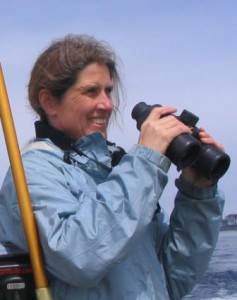
Jane Watson
Adjunct Professor
Tel: 250 753 3245 local 2317
email: Jane.Watson@viu.ca
Education: BSc Biology (University of British Columbia) PhD Biology (University of California at Santa Cruz)
Current Position: Faculty member at Vancouver Island University
Research Interests: My primary interest is how marine vertebrates affect coastal ecosystems on an ecological and evolutionary scale. I have had the opportunity to work on a variety of projects which have included applied fisheries biology as well as academic studies of cetaceans, pinnipeds, sea otters, invertebrates, fish and marine algae. This background has given me a broad view of marine community structure and function, something that I feel is important in both my research and teaching. My principal area of research is in sea otter community ecology. Specifically I am interested in the ecological effects that sea otters have on the structure of nearshore ecological communities. For the past 20+ years I have been working off the northwest coast of Vancouver Island studying the effect that the growing sea otter population is having on coastal ecosystems, particularly those found in rocky areas. As a community ecologist my research is conducted above and below the ocean’s surface.
Current Projects:
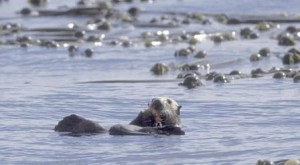
sea otter with kelp
Monitoring Sea Otter Population Growth
Sea otters which were much valued for their luxurious fur, were extirpated from BC in an intensive fur trade that lasted from the late 1700s until 1911. Otters were reintroduced to the west coast of Vancouver Island from 1969 to 1972. This introduction was very successful and by 2005 the Canadian sea otter population had grown to nearly 3500 hundred individuals and spread from their reintroduction site north and south along Vancouver Island. In collaboration with colleagues from DFO I have been monitoring the growth and expansion of the sea otter population along the west coast of Vancouver Island since 1987. Each summer I conduct surveys to document the abundance of sea otters in and around their original reintroduction site. The results of this ongoing project, which documents how sea otter populations grow, spread and ultimately become density dependent, has been used to test hypotheses about the historical carrying capacity of sea otters in BC as well as the habitat needs of this important coastal predator.
Long-term variation in subtidal community structure: sea otters and natural variation.
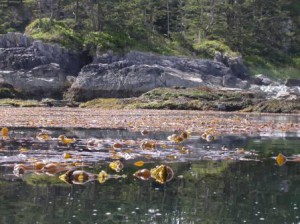
Kelp off the B.C. coast
Since 1987 I have been documenting long-term variation in rocky subtidal communities off the west coast of Vancouver Island. Nearshore communities are known to vary in response to biological and environmental factors. The return of sea otters to the west coast of Vancouver Island has resulted in a decline the biomass and size of many invertebrates populations but increased kelp abundance. I am interested in kelp forest communities vary over time in response to the return of sea otters and to changing environmental events such as the El Niño Southern Oscillation Events (ENSO) and the Pacific Decadal Oscillation (PDO) affect BC kelp forests. Each year I monitor the abundance of algae and invertebrates at six permanently marked sites located in areas with sea otters, and at two sites in areas without sea otters. These long term, but site specific data are compared to the data collected from 60 randomly selected sites sampled at 6-9 year intervals from within the same areas.
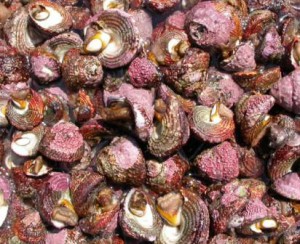
red turban snail (Lithopoma gibberosa)
The effects of otter predation on prey species
Sea otters, which eat about 25% of their body weight in prey each day, have a profound effect on the abundance and size their invertebrate prey populations. I am interested in how the extirpation of sea otters, and the subsequent reduction in predation pressure affected the life history characteristics of their prey. I have been using the red turban snail (Lithopoma gibberosa) as a model species to examine how sea otter predation affects the population dynamics and behaviour of their prey species. To do this I have been comparing the density, size, biomass, movement, and growth of this species at six sites in areas with sea otters and at six sites in areas without sea otters. To date the results indicate that the predation pressure in areas with and without sea otters is very different and affects the population dynamics the snails both directly and indirectly. The results of this ongoing study suggest that the population dynamics of this model species change dramatically in response to otter predation and that our understanding of invertebrate population dynamics may need some revising as sea otter populations expand along the coast of BC.
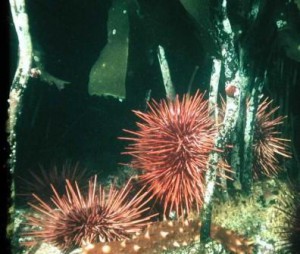 Graduate Student Opportunities:
Graduate Student Opportunities:
My full time teaching commitments at Vancouver Island University make it difficult for me to supervise graduate students in an effective manner. Instead I enjoy working closely with graduate students as on advisory committees and in a more informal advisory capacity. I regularly work with both graduate and undergraduate students in the field and lab.
Recent Reports and Publications
Gregr, E. L. Nichol, J. Watson, J. Ford, G. Ellis (In Press). Estimating the carrying capacity for sea otters (Enhydra lutris) in British Columbia. Journal of Wildlife Management.
Nichol. L.M., J.C. Watson, G.M. Ellis, and J.K.B. Ford. (2005) An assessment of abundance and growth of the sea otter population (Enhydra lutris) in British Columbia. DFO Res. Doc. 2005 / 094. Available at: http://www.dfo-mpo.gc.ca/csas
Update status of the sea otter (Enhydra lutris) in Canada (2006). Committee on the Status of Endangered Wildlife in Canada. Written by L. Nichol and J. Watson for COSEWIC. Available at: http://www.cosewic.gc.ca
